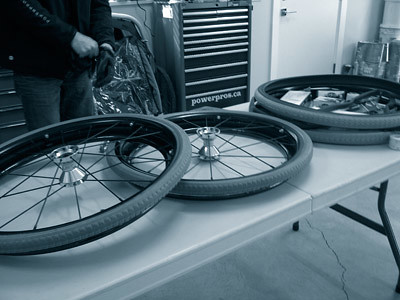
Yesterday my friend Kirby and I changed the tires on my wheelchair. The original tires had finally worn out, with bits of the inside carcass peeking out from what little bit of tread was left. When I took part in the wheeling study last year (part 1, part 2), the researchers said I would notice a difference if I switched from the solid-insert tires to tube-type, as the lighter weight would make it easier to roll. With that in mind, I decided to use Schwalbe Marathon Plus tires. My friend Eric set me up with the tires, tubes, some tire irons and rim tape - everything necessary to make the swap.
It was much easier than we were expecting to change the tires. Kirby and I cut the old tires off, removed the inserts and had the new tires on in less than an hour. Luckily I have a second set of wheels for my chair so I could help at least a little bit, rather than being stuck on a couch or on the floor somewhere! Fixing a flat should be fairly easy, and I have put a spare tube, the irons and a small pump in my backpack. The Marathon Plus tires are thick to reduce the chance of a puncture, and we used heavy-duty tubes, so hopefully I won't have to fix a flat anytime soon.
The new tires have made a big change to how my wheelchair rolls. It's about the same on carpet, but on wood or concrete it is way easier to push. As well, the pneumatic tires are quite a bit smoother over bumps and cracks in the pavement. The heavy-duty tires and tubes didn't seem to be that much lighter than the original tires and inserts, but evidently it doesn't take much to make a difference. I have some regular tubes, which are quite a bit lighter than the heavy-duty tubes, and plan to try them at some point.




You gotta stop wicking it up in the corners!
ReplyDeleteYou can possibly setup your wheels tubeless. Check out Stan's tubeless conversions. That'll allow you to run a bit lower pressure, have less resistance without the friction of the tubes, and pretty much eliminate flats.
ReplyDelete